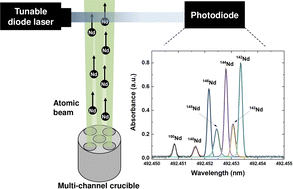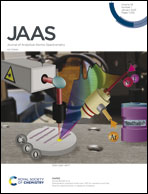In situ detection of neodymium isotopes using tunable diode laser absorption spectroscopy for nuclear forensic analysis
Abstract
As evidence for tracing the history of nuclear materials, in situ detection of neodymium isotopes using tunable diode laser absorption spectroscopy (TDLAS) was investigated. A compact optical configuration was constructed by integrating laser optics and sample vaporization apparatus. The absorption spectra of all naturally occurring neodymium isotopes were measured from the interaction between collimated neodymium vapor and a tunable diode laser. Under optimized conditions for weakening the Doppler effect, seven neodymium isotopes could be clearly identified in the absorption spectra notwithstanding their small isotopic shifts (about 0.3 pm). By comparing these distinctive absorption peaks, the isotopic abundance could be accurately estimated with about 0.24% absolute bias. Furthermore, the detection limit of neodymium in various oxide matrices was evaluated to verify the sensitivity of the system. Although the direct absorption mode exhibited insufficient absorbance, the signal amplification methods including chemical reduction and wavelength modulation successfully improved the detection limit down to the ppm level. Consequently, the present research reported for the first time the absorption spectra of seven neodymium isotopes and also demonstrated the feasibility of a TDLAS-based detection system for isotope analysis in nuclear forensics.



 Please wait while we load your content...
Please wait while we load your content...